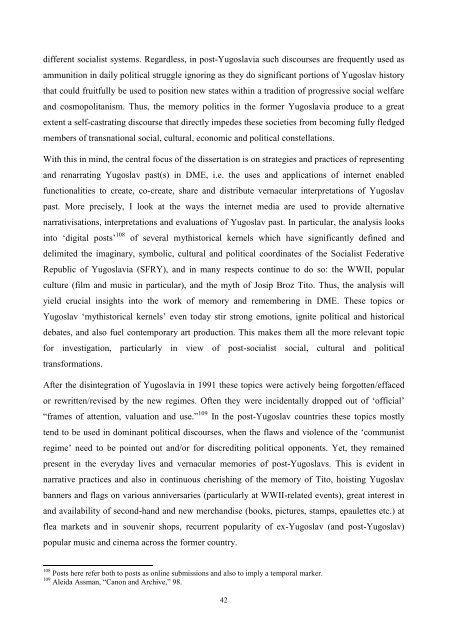UNIVERSITY OF NOVA GORICA GRADUATE SCHOOL ...
UNIVERSITY OF NOVA GORICA GRADUATE SCHOOL ...
UNIVERSITY OF NOVA GORICA GRADUATE SCHOOL ...
You also want an ePaper? Increase the reach of your titles
YUMPU automatically turns print PDFs into web optimized ePapers that Google loves.
different socialist systems. Regardless, in post-Yugoslavia such discourses are frequently used as<br />
ammunition in daily political struggle ignoring as they do significant portions of Yugoslav history<br />
that could fruitfully be used to position new states within a tradition of progressive social welfare<br />
and cosmopolitanism. Thus, the memory politics in the former Yugoslavia produce to a great<br />
extent a self-castrating discourse that directly impedes these societies from becoming fully fledged<br />
members of transnational social, cultural, economic and political constellations.<br />
With this in mind, the central focus of the dissertation is on strategies and practices of representing<br />
and renarrating Yugoslav past(s) in DME, i.e. the uses and applications of internet enabled<br />
functionalities to create, co-create, share and distribute vernacular interpretations of Yugoslav<br />
past. More precisely, I look at the ways the internet media are used to provide alternative<br />
narrativisations, interpretations and evaluations of Yugoslav past. In particular, the analysis looks<br />
into ‗digital posts‘ 108 of several mythistorical kernels which have significantly defined and<br />
delimited the imaginary, symbolic, cultural and political coordinates of the Socialist Federative<br />
Republic of Yugoslavia (SFRY), and in many respects continue to do so: the WWII, popular<br />
culture (film and music in particular), and the myth of Josip Broz Tito. Thus, the analysis will<br />
yield crucial insights into the work of memory and remembering in DME. These topics or<br />
Yugoslav ‗mythistorical kernels‘ even today stir strong emotions, ignite political and historical<br />
debates, and also fuel contemporary art production. This makes them all the more relevant topic<br />
for investigation, particularly in view of post-socialist social, cultural and political<br />
transformations.<br />
After the disintegration of Yugoslavia in 1991 these topics were actively being forgotten/effaced<br />
or rewritten/revised by the new regimes. Often they were incidentally dropped out of ‗official‘<br />
―frames of attention, valuation and use.‖ 109 In the post-Yugoslav countries these topics mostly<br />
tend to be used in dominant political discourses, when the flaws and violence of the ‗communist<br />
regime‘ need to be pointed out and/or for discrediting political opponents. Yet, they remained<br />
present in the everyday lives and vernacular memories of post-Yugoslavs. This is evident in<br />
narrative practices and also in continuous cherishing of the memory of Tito, hoisting Yugoslav<br />
banners and flags on various anniversaries (particularly at WWII-related events), great interest in<br />
and availability of second-hand and new merchandise (books, pictures, stamps, epaulettes etc.) at<br />
flea markets and in souvenir shops, recurrent popularity of ex-Yugoslav (and post-Yugoslav)<br />
popular music and cinema across the former country.<br />
108 Posts here refer both to posts as online submissions and also to imply a temporal marker.<br />
109 Aleida Assman, ―Canon and Archive,‖ 98.<br />
42

















